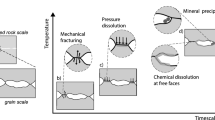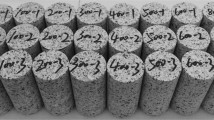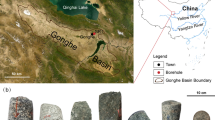Abstract
Increasing fracture aperture by lowering effective normal stress and by inducing dilatant shearing and thermo-elastic effects is essential for transmissivity increase in enhanced geothermal systems. This study investigates transmissivity evolution for fluid flow through natural fractures in granodiorite at the laboratory scale. Processes that influence transmissivity are changing normal loads, surface deformation, the formation of gouge and fracture offset. Normal loads were varied in cycles between 1 and 68 MPa and cause transmissivity changes of up to three orders of magnitude. Similarly, small offsets of fracture surfaces of the order of millimeters induced changes in transmissivity of up to three orders of magnitude. During normal load cycling, the fractures experienced significant surface deformation, which did not lead to increased matedness for most experiments, especially for offset fractures. The resulting gouge material production may have caused clogging of the main fluid flow channels with progressing loading cycles, resulting in reductions of transmissivity by up to one order of magnitude. During one load cycle, from low to high normal loads, the majority of tests show hysteretic behavior of the transmissivity. This effect is stronger for early load cycles, most likely when surface deformation occurs, and becomes less pronounced in later cycles when asperities with low asperity strength failed. The influence of repeated load cycling on surface deformation is investigated by scanning the specimen surfaces before and after testing. This allows one to study asperity height distribution and surface deformation by evaluating the changes of the standard deviation of the height, distribution of asperities and matedness of the fractures. Surface roughness, as expressed by the standard deviation of the asperity height distribution, increased during testing. Specimen surfaces that were tested in a mated configuration were better mated after testing, than specimens tested in shear offset configuration. The fracture surface deformation of specimen surfaces that were tested in an offset configuration was dominated by the breaking of individual asperities and grains, which did not result in better mated surfaces.














Similar content being viewed by others
References
Barton N, Bandis S, Bakhtar K (1985) Strength, deformation and conductivity coupling of rock joints. Int J Rock Mech Min Sci 22(3):121–140
Brown SR (1987) Fluid-flow through rock joints—the effect of surface-roughness. J Geophys Res-Solid Earth Planets 92(B2):1337–1347
Chen Z, Narayan S, Yang Z, Rahman S (2000) An experimental investigation of hydraulic behaviour of fractures and joints in granitic rock. Int J Rock Mech Min Sci 37(7):1061–1071
Cook NGW (1992) Natural joints in rock*—mechanical, hydraulic and seismic behavior and properties under normal stress. Int J Rock Mech Min Sci Geomech Abstr 29(3):198–223
Durham WB, Bonner BP (1994) Self-propping and fluid-flow in slightly offset joints at high effective pressures. J Geophys Res-Solid Earth 99(B5):9391–9399
Esaki T, Hojo H, Kimura T, Kameda N, Deut Gesell E, Grundbau (1991) Shear-flow coupling test on rock joints. In: Proceedings—seventh international congress on rock mechanics, vol 1. Rock mechanics and environmental protection
Esaki T, Du S, Mitani Y, Ikusada K, Jing L (1999) Development of a shear-flow test apparatus and determination of coupled properties for a single rock joint. Int J Rock Mech Min Sci 36(5):641–650
Evans KF (2005) Permeability creation and damage due to massive fluid injections into granite at 3.5 km at soultz: 2. critical stress and fracture strength. J Geophys Res Solid Earth 110(B4):1–14
Gentier S, Hopkins D, Riss J (2013) Role of fracture geometry in the evolution of flow paths under stress. In: Faybishenko B, Witherspoon PA, Benson SM (eds) Dynamics of fluids in fractured rock, American Geophysical Union, pp 169–184. doi:10.1029/GM122p0169
Hakami E, Larsson E (1996) Aperture measurements and flow experiments on a single natural fracture. Int J Rock Mech Min Sci Geomech Abstr 33(4):395–404
Hakami, E and Einstein, H H and Gentier, S and Iwano, M (1993) Characterisation of fracture apertures-Methods and parameters. 8th ISRM congress 1995
Iwano M, Einstein H (1993) Stochastic analysis of surface roughness, aperture and flow in a single fracture. In: Proceedings of the ISRM International Symposium Eurock ’93. Lisbon. pp 135–1441
Kim HM, Inoue J (2003) Analytical approach for anisotropic permeability through a single rough rock joint under shear deformation. J Geophys Res Solid Earth 108(8):5-1–5-10
Lee HS, Cho TF (2002) Hydraulic characteristics of rough fractures in linear flow under normal and shear load. Rock Mech Rock Eng 35(4):299–318. doi:10.1007/s00603-002-0028-y
Li B, Jiang Y, Koyama T, Jing L, Tanabashi Y (2008) Experimental study of the hydro-mechanical behavior of rock joints using a parallel-plate model containing contact areas and artificial fractures. Int J Rock Mech Min Sci 45(3):362–375
Li Y, Chen Y, Zhou C (2014) Hydraulic properties of partially saturated rock fractures subjected to mechanical loading. Eng Geol 179:24–31
Louis C (1969) A study of groundwater flow in jointed rock and its influence on the stability of rock masses. Rock mechanics research, report 10
McClure M, Horne R (2014) Characterizing hydraulic fracturing with a tendency-for-shear-stimulation test. Spe Reserv Eval Eng 17(2):233–243
Oron AP, Berkowitz B (1998) Flow in rock fractures: the local cubic law assumption reexamined. Water Resour Res 34(11):2811–2825. doi:10.1029/98wr02285
Park H, Osada M, Matsushita T, Takahashi M, Ito K (2013) Development of coupled shear-flow-visualization apparatus and data analysis. Int J Rock Mech Min Sci 63:72–81. doi:10.1016/j.ijrmms.2013.06.003
Pyrak-Nolte LJ, Morris JP (2000) Single fractures under normal stress: the relation between fracture specific stiffness and fluid flow. Int J Rock Mech Min Sci 37(1–2):245–262. doi:10.1016/s1365-1609(99)00104-5
Raven KG, Gale JE (1985) Water-flow in a natural rock fracture as a function of stress and sample-size. Int J Rock Mech Min Sci 22(4):251–261
Renshaw CE (1995) On the relationship between mechanical and hydraulic apertures in rough-walled fractures. J Geophys Res-Solid Earth 100(B12):24,629–24,636. doi:10.1029/95jb02159
Rutqvist J, Stephansson O (2003) The role of hydromechanical coupling in fractured rock engineering. Hydrogeol J 11(1):7–40
Shugang W, Elsworth D, Jishan L (2013) Mechanical behavior of methane infiltrated coal: the roles of gas desorption, stress level and loading rate. Rock Mech Rock Eng 46(5):945–958. doi:10.1007/s00603-012-0324-0
Takana Y, Miyakawa K, Fukahori D, Kiho K, Goto K (2014) Survey of flow channels in rock mass fractures by resin injection. Asian rock mechanics symposium 8
Tester JW, Anderson BJ, Batchelor AS, Blackwell DD, DiPippo R, Drake EM, Garnish J, Livesay B, Moore MC, Nichols K, Petty S, Toksöz MN, Veatch RW, Baria R, Augustine C, Murphy E, Negraru P, Richards M (2006) The Future of geothermal energy; impact of enhanced geothermal systems (EGS) on the United States in the 21st century. Technical report INL/EXT-06-11746, Idaho National Laboratory
Walsh JB (2003) A theoretical analysis of sliding of rough surfaces. J Geophys Res-Solid Earth 108(B8). doi:10.1029/2002jb002127
Wang S, Elsworth D, Liu J (2011) Permeability evolution in fractured coal: the roles of fracture geometry and water-content. Int J Coal Geol 87(1):13–25
Witherspoon PA, Wang JSY, Iwai K, Gale JE (1980) Validity of cubic law for fluid-flow in a deformable rock fracture. Water Resour Res 16(6):1016–1024
Xiong X, Li B, Jiang Y, Koyama T, Zhang C (2011) Experimental and numerical study of the geometrical and hydraulic characteristics of a single rock fracture during shear. Int J Rock Mech Min Sci 48(8):1292–1302
Yeo IW, De Freitas MH, Zimmerman RW (1998) Effect of shear displacement on the aperture and permeability of a rock fracture. Int J Rock Mech Min Sci 35(8):1051–1070
Zhong Z, Elsworth D, Hu Y (2014) Evolution of strength and permeability in stressed fractures with fluid-rock interactions. Pure Appl Geophys 173(2):525–536. doi:10.1007/s00024-015-1099-5
Zhu WC, Liu J, Elsworth D, Polak A, Grader A, Sheng JC, Liu JX (2007) Tracer transport in a fractured chalk: X-ray ct characterization and digital-image-based (dib) simulation. Transport Porous Media 70(1):25–42
Zimmerman RW, Kumar S, Bodvarsson GS (1991) Lubrication theory analysis of the permeability of rough-walled fractures. Int J Rock Mech Min Sci Geomech Abstr 28(4):325–331
Zimmerman RW, Bodvarsson GS (1996) Hydraulic conductivity of rock fractures. Transport Porous Media 23(1):1–30
Acknowledgments
The authors want to thank two anonymous reviewers for their constructive suggestions which helped to improve this work. The authors further want to thank the National Cooperative for the Disposal of Radioactive Waste (Nagra), Switzerland, and the CRIEPI fractured rock study Takana et al. (2014) for providing us with the specimen material for our study. The authors further want to thank the chair of geosensors and engineering geodesy at ETH Zurich for their support with the photogrammetry scanner. This work was partially supported by the GEOTHERM II project, which is funded by the Competence Center Environment and Sustainability of the ETH Domain. This project benefitted from partial funding from DOE DE-FE0023354.
Author information
Authors and Affiliations
Corresponding author
Rights and permissions
About this article
Cite this article
Vogler, D., Amann, F., Bayer, P. et al. Permeability Evolution in Natural Fractures Subject to Cyclic Loading and Gouge Formation. Rock Mech Rock Eng 49, 3463–3479 (2016). https://doi.org/10.1007/s00603-016-1022-0
Received:
Accepted:
Published:
Issue Date:
DOI: https://doi.org/10.1007/s00603-016-1022-0




